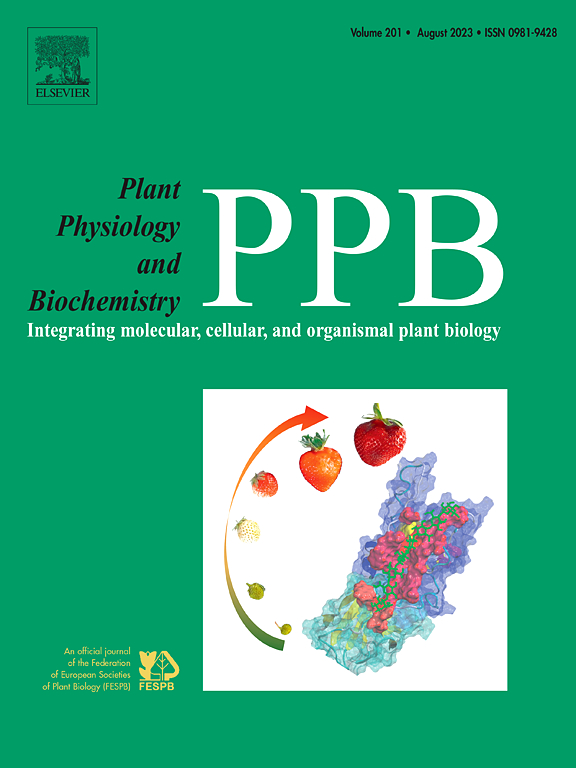Fes-palygorskite nanocomposite mitigated early chlorosis in direct-seeded rice improving physiological and biochemical attributes
IF 5.7
2区 生物学
Q1 PLANT SCIENCES
引用次数: 0
Abstract
Early-stage chlorosis due to iron deficiency is a critical limitation in direct-seeded rice (DSR) cultivation under aerobic and alkaline soil conditions, where iron bioavailability is severely restricted. This study presents a nano-engineered FeS-palygorskite composite (Fs-Pg) as a sustainable alternative to conventional ferrous sulfate (FeSO4), enabling prolonged ferrous ion availability under alkaline conditions. Response Surface Methodology (RSM) optimized a controlled release of 2.13 mg/kg iron over 29.6 days for Fs-Pg, maintaining higher ferrous ion content (0.43 mg/kg), in contrast to FeSO4, which showed a rapid release (3.44 mg/kg) with lower ferrous ion retention (0.19 mg/kg) within 8.6 days at their respective optimized dosages. Korsmeyer–Peppas model (n = 0.738) was the most fitted kinetic model endorsed a non-Fickian, dual-controlled release mechanism for Fe2+ release, driven by diffusion and sulfide-mediated slow dissolution. Significant enhancement in seedling physiological parameters (after 30 days) included improved germination rate (8.80 %), root length (20.66 %), biomass accumulation (fresh weight: 68.37 %; dry weight: 35.29 %) and overall vigor index (47.26 %) as compared to FeSO4. The treatment also enhanced iron uptake in shoots (9.58 %) and roots (10.36 %) relative to FeSO4. Fs-Pg application markedly elevated antioxidant enzyme activities (superoxide dismutase, ascorbate peroxidase, catalase, polyphenol oxidase and peroxidase) and boosted biochemical attributes (phenolics, flavonoids, protein and chlorophyll content), contributing to reduced oxidative stress and enhanced redox homeostasis. Free radical scavenging assays further confirmed its superior antioxidative potential. Overall, this study offered a sustainable nanonutrient solution for augmented bioavailable iron under aerobic conditions in DSR, coupled with enhanced antioxidant defense, and improved physiological growth to effectively mitigate early-stage chlorosis under alkaline stress.

铁-坡壁石纳米复合材料减轻了直播水稻早期黄化,改善了生理生化性状
在好氧和碱性土壤条件下,铁的生物有效性受到严重限制,缺铁导致的早期黄化是直接播种水稻(DSR)栽培的一个关键限制。本研究提出了一种纳米工程的fes -坡壁石复合材料(Fs-Pg),作为传统硫酸亚铁(FeSO4)的可持续替代品,在碱性条件下延长了亚铁离子的可用性。响应面法(RSM)优化了Fs-Pg在29.6 d内控释2.13 mg/kg铁,并保持较高的亚铁离子含量(0.43 mg/kg),而FeSO4则在8.6 d内快速释放(3.44 mg/kg),并保持较低的亚铁离子滞留(0.19 mg/kg)。Korsmeyer-Peppas模型(n = 0.738)是最拟合的动力学模型,支持Fe2+的非菲克式双控释放机制,由扩散和硫化物介导的缓慢溶解驱动。幼苗生理参数(30 d后)显著提高包括发芽率(8.80%)、根长(20.66%)、生物量积累(鲜重:68.37%;干重为35.29%),总活力指数为47.26%。相对于FeSO4,处理还能提高茎部(9.58%)和根(10.36%)对铁的吸收。应用Fs-Pg可显著提高抗氧化酶(超氧化物歧化酶、抗坏血酸过氧化物酶、过氧化氢酶、多酚氧化酶和过氧化物酶)活性,提高生物化学特性(酚类物质、类黄酮、蛋白质和叶绿素含量),有助于降低氧化应激,增强氧化还原稳态。自由基清除试验进一步证实了其优越的抗氧化潜力。总的来说,本研究提供了一种可持续的纳米营养液,可以在好氧条件下增加DSR的生物可利用铁,同时增强抗氧化防御,促进生理生长,有效缓解碱胁迫下的早期黄化。
本文章由计算机程序翻译,如有差异,请以英文原文为准。
求助全文
约1分钟内获得全文
求助全文
来源期刊
CiteScore
11.10
自引率
3.10%
发文量
410
审稿时长
33 days
期刊介绍:
Plant Physiology and Biochemistry publishes original theoretical, experimental and technical contributions in the various fields of plant physiology (biochemistry, physiology, structure, genetics, plant-microbe interactions, etc.) at diverse levels of integration (molecular, subcellular, cellular, organ, whole plant, environmental). Opinions expressed in the journal are the sole responsibility of the authors and publication does not imply the editors'' agreement.
Manuscripts describing molecular-genetic and/or gene expression data that are not integrated with biochemical analysis and/or actual measurements of plant physiological processes are not suitable for PPB. Also "Omics" studies (transcriptomics, proteomics, metabolomics, etc.) reporting descriptive analysis without an element of functional validation assays, will not be considered. Similarly, applied agronomic or phytochemical studies that generate no new, fundamental insights in plant physiological and/or biochemical processes are not suitable for publication in PPB.
Plant Physiology and Biochemistry publishes several types of articles: Reviews, Papers and Short Papers. Articles for Reviews are either invited by the editor or proposed by the authors for the editor''s prior agreement. Reviews should not exceed 40 typewritten pages and Short Papers no more than approximately 8 typewritten pages. The fundamental character of Plant Physiology and Biochemistry remains that of a journal for original results.

 求助内容:
求助内容: 应助结果提醒方式:
应助结果提醒方式:


